Buying and Selling Guide to Luxury Condominiums in San Francisco
As a top-producing local real estate team, we’re committed to giving you excellent personalized service. This guide offers a timely analysis of the housing market for luxury condominiums (condos) in San Francisco— specifically South of Market (SOMA), Mission Bay, and South Beach—that will help you strengthen your negotiating position as a buyer or seller, develop a winning buying or selling strategy, and answer questions you might have during this time. At the time of writing this guide, we are navigating through an unprecedented response to COVID-19. The situation is impacting the real estate market in several ways. First, interest rates will likely remain historically low for the foreseeable future. This encourages potential home buyers to take advantage of low-interest financing, makes investments in real estate safer than other assets like stocks, and offsets some of the negative impacts to housing demand associated with the global pandemic. On the other hand, the housing market is being challenged; unemployment has reached historical highs, virtual showings in response to social distancing are limiting buyer interest, and home sellers are pulling their listings off the market.
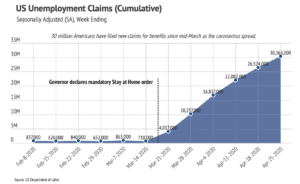
No matter what the future holds, shelter remains a basic need. Life events—such as relocations, divorces, and deaths—still require people to buy or sell real estate. Real estate has been declared an essential service because everyone needs shelter, particularly in the time of social distancing. To that end, we remain committed to keeping you informed about local market conditions.
The fundamentals of developing a winning buying and selling strategy remain the same, one that takes into account the current housing market indicators in your local market. With that in mind, in this guide we will cover:
- Housing Market Behavior During the Pandemic
- San Francisco Housing Trends
- Key Housing Market Indicators for SOMA, South Beach, and Mission Bay
Housing Market Behavior During the Pandemic
Unlike the 2008 global financial crisis, the current economic downturn stems from a virus rather than huge systematic market risks. COVID-19 has shown our economic fragility with regard to businesses that require customers to leave their residences, but it hasn’t wiped out nearly the amount of wealth that was erased in 2008. Chief Economist of the California Association of Realtors, Leslie Appleton-Young, made the following statement on April 1st:
“Going into [the pandemic] the housing sector was in a very, very strong position . . . The latest data that we had pre-virus was the February sales data. [They were] the strongest numbers that we had in two years . . . The underwriting is really good, the credit scores are good.”
On March 15, the Federal Reserve (Fed) cut the federal funds rate to zero and announced the purchase of $1.5 trillion in U.S. Treasury securities as well as several hundred billion in mortgage-backed securities. On March 23, the Fed announced that it would purchase an unlimited amount of Treasury securities and mortgaged-backed securities to support financial markets. This process of quantitative easing, which increases the money supply, was last used in the 2008 financial crisis in an effort to encourage lending and investment and will keep rates low for the foreseeable future. The actions by the Fed will help to further reduce the cost of borrowing and make housing more affordable over the near term.
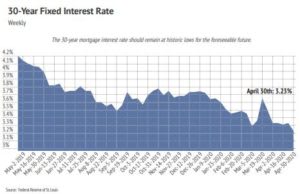
For buyers who are less affected by the economic uncertainty, lower rates provide an opportunity to capitalize on significantly reduced borrowing costs that they will enjoy for years to come. Short-run risks to the economy exist but are arguably offset by long-run benefits of lower rates. Low-interest financing also makes investments in real estate less risky than investments in assets such as stocks.
While rates remain low, mortgage loans could be harder to qualify for. JP Morgan Chase was the first of the big banks to report that they are tightening their lending standards. Starting April 14th, borrowers applying for a mortgage with Chase will need a credit score of at least 700 and make a down payment of at least 20% of the home’s appraised value (this does not apply for existing mortgages or to low and moderate-income borrowers who qualify for other loans). Although JP Morgan Chase does not disclose its mortgage lending standards, the Mortgage Bankers Association reports an average down payment of 10%. This change in standards could affect demand. In a market like San Francisco where a median condo cost just under $1.3 million in March, the difference between a 10% down payment and a 20% down payment is $130,000. Even in the most affluent areas, a $130,000 jump in immediate cash could price buyers out of the market.
With all of the above dynamics playing out on a national and global stage, it’s fair to ask when we will see a semblance of normalcy. To answer this, we first look at the projected hospitalizations due to COVID-19.
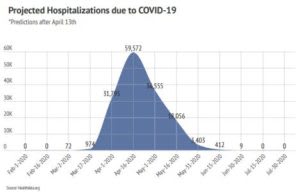
April 19th marked the peak of hospitalizations due to COVID-19—the model estimates peak hospital resources used between April 19-29. Health experts predict that peak COVID-19 hospital resources will drop to zero by mid-July, an encouraging trend indicating a reduction in the spread of the virus.
In her April 1st statement, Appleton-Young added the following:
“I think there is going to be a bit of a price hit because the demand side is going to be hobbled by the shutdown in the economy . . . but I don’t think it’s going to be big because supply is so constrained. The question is, are we going to see a flood of foreclosures on the market? I don’t think that is going to happen this year [because] when you look at what is happening in Washington, what is very clear is we know how to fight the war.”
In other words, as long as both supply and demand decrease at the same time, prices should not bottom out like they did in 2008 unless a large number of properties go into foreclosure.
San Francisco Housing Trends
The pandemic’s impact on the housing market is progressing so rapidly that we can see its effects on a weekly basis. The graph below illustrates the available housing inventory not by month (as is typical) but by week. We can see that supply levels began declining even before California’s Governor Newson issued a statewide stay-at-home order. A decrease in active listings usually indicates a corresponding increase in sales. In the month of March, however, it showed a surge in listings being pulled off the market.
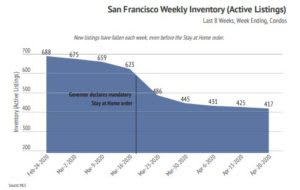
In already tight markets like San Francisco, this rapid decline in supply was bad news for buyers. With less inventory on the market and less buyer demand, home sales fell for both single-family homes and condos. We take a look at condo sales, again on a weekly basis, which has fallen by over half since mid-March.
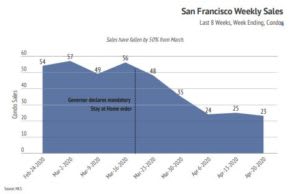
CAR’s Appleton-Young commented on this trend in her April market update:
“All sales volumes have been impacted at this point. I think it’s going to bottom and then as people figure out virtual transactions, it will come back up.”
While we pride ourselves on being at the forefront of virtual transactions, the process is new for many buyers and sellers. It will take time to get comfortable with the new way of doing business.
__________________
Measuring the rest of our data monthly and with a longer-term perspective is still important because it illustrates the health of the housing market before the global pandemic. Keep in mind, there is a lag of at least 30 days between when a contract is accepted, and when the sale of a home finally closes. This means that March data, such as median sales prices, reflects the market before the shelter-in-place rules went into effect.
During the previous economic crisis in 2008, the housing market’s decline was driven by contagion within the housing market itself. This time, a robust housing market preceded the current moment. We also saw several market conditions over the last 12 months that we expect to see moving forward: interest rates at historical lows and affordability increasing for home buyers.
San Francisco’s condo prices dipped slightly in March. Although the pandemic and stay-at-home order dampened buyer demand, the number of active listings also decreased, which kept prices fairly stable. This puts more pressure on buyers to get offers accepted before conditions worsen and even more listings disappear.
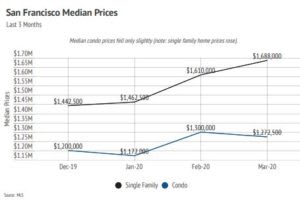
With condo prices relatively flat, the percentage of condos that sold with a price cut remained near its lowest level over the past 12 months. Only 10% of sellers had to reduce their prices in March, which means buyers were the ones making price concessions and making competitive offers to get accepted.
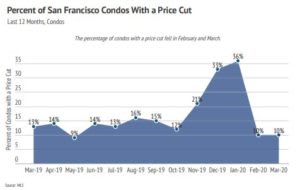
The sale-to-list ratio reflects the change in the original list price of a home and the final sale price. For example, a ratio of 100% means that a home sold for the price it was most recently listed. Single-family homes typically have higher sale-to-list ratios than condos.
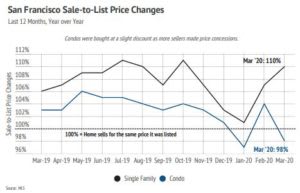
In March, buyers paid a slight discount for condos, which sold below list (98%).
Housing Market Update for San Francisco Luxury Condos
Now we take a look at the San Francisco luxury condo market data to refine a winning buying and selling strategy. Here is a snapshot of the housing market in March 2020 across several key indicators. As the market conditions change in response to the global pandemic, we can look at this data in real-time to make the best decisions. We use data specifically for condos in 94158, 94105, and 94107 zip codes.
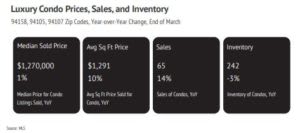
The SOMA, South Beach, and Mission Bay condo market was slightly more affordable than the surrounding San Francisco condo market in March ($1.275M for the median SF condo). Median condo prices were up 1% compared to the previous year. Typically, appreciating prices encourage sellers to price their listing slightly above comparables. Sales were also up 14%.
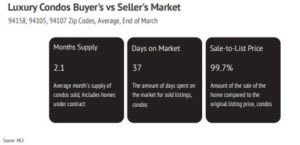
The SOMA, South Beach, and Mission Bay condo market is balanced, meaning it has aspects that favor both buyers and sellers.
In March, the month’s supply was 2.1, which means there were 2.1 months of listings on the market at the current rate of sales (includes listings under contract). Analysts consider a balanced California market to have 3 months of supply.
Days on Market implies that sellers should expect offers to be accepted in 37 days on average, a much lower amount than the surrounding city. If it’s taking longer to receive offers, sellers should consider reducing their prices. Buyers should proceed with caution and consult with an experienced agent before making an offer on a home that’s been on the market for longer than 37 days because it may be priced too high or something else may be wrong.
The California Association of Realtors’ guidance on reporting DOM has led us to believe that the metric will be highly unreliable in the near term, and we will not rely on this metric in the near-term until a uniform process is decided. MLSs can independently choose to freeze DOM, which renders the metric unusable. With that, we know DOM will show a noticeable increase through the coming months as the sales process goes virtual. Usually, DOM shows if a home was priced properly, but for the time being, we believe an increase in DOM for those that continue to list will not accurately reflect an improper price point.
Lastly, we look at the sale-to-list price ratio, which is an indicator that reflects the negotiation power of home buyers and home sellers under current market conditions. In March, the median condo sold for 99.7% of its original listing price, so buyers and sellers should expect to negotiate offers at list price. It also indicates that neither sellers nor buyers are making many price concessions.
The Importance of Listing a Condo at the Right Price
We can split sold condos into two categories: condos sold without a price reduction and condos sold with one or more price reductions. Price reductions may indicate problems that need to be fixed or poor marketing and showings. More often, however, price reductions happen because the condo was overpriced and misaligned with market data from the beginning.
Overpricing a condo can create a negative feedback loop: Initial offers fail to materialize because the condo is overpriced, the days on market surpasses the average, and a new crop of potential buyers assume there’s something wrong with the property. More price reductions and low offers may follow, with the final selling price coming in well-below what the property could have garnered had it been priced correctly in the first place.
In SoMa, South Beach, and Mission Bay, 59 condos sold without price changes, recording 102% of their original listing prices, and spent only 25 days on the market. In contrast, the 6 homes that sold with one or more price reductions recorded only 88% of their original listing prices and spent over three times as long (86 days) on the market. These numbers underscore the importance of not overpricing a home for sale.
Conclusion
We want to assure you that of all investments you can make, real estate has historically proven to be the best asset you can own in the long-term, and we expect this to continue to be the case.
In unprecedented times like these, it’s important to band together and support one another. Our team is committed to serving all your real estate needs while incorporating safety protocols to protect your loved ones. As we all navigate this together, please don’t hesitate to reach out to us with any questions or concerns. We’re here to support you.
